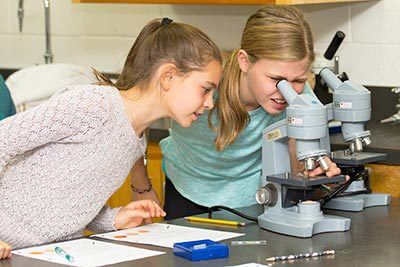February 1, 2018
 by Erica Brewinski, Middle School Director
by Erica Brewinski, Middle School Director
“Birthday candle smell is hot rods lab!” I’m guessing that most people, upon seeing this message in the subject line of an email, would surmise that it is: a) spam, b) a link to a funny YouTube video sent by a coworker, or c) a line from a recent late night show. For me, and all of the faculty and staff who received that message on Tuesday, the message is further evidence that our Middle School students are highly engaged in a collaborative, hands on learning experiences.
Upon investigation, I indeed found sixth grade students clustered around lab stations, talking animatedly as they tested their hypotheses. Next door, the eighth graders were working in small groups on a problem-based activity that required them to study various factors to determine the best location for a research station in Yellowstone Park. Each group then had to give a five-minute pitch to an outside scientist. These types of project-based, open-ended learning activities include real world applications and use multiple 21st century skills, and they permeate our Middle School experience. MPA is helping students to dream big and do right; our students are actively engaged in their own learning, teachers are discovering ways to weave together content from many disciplines into projects, and our classrooms have seen positive changes with the addition of our one-to-one laptop program.
For most of us, Confucius’s statement that, “I hear and I forget. I see and I remember. I do and I understand.” holds true whether we are cooking a new recipe, deciphering financial figures, or learning a new sport. It begs to question, then, why so many schools across the country continue to feature a teacher standing at the front of a room delivering information to bored students. When I pop into classrooms at MPA, I see students asking questions, driven by their natural curiosity to understand more. I observe students designing, creating, testing, and failing, and watch as they discuss and analyze their mistakes and try again. I notice the integration of STEAM—Science, Technology, Engineering, Arts, and Math—throughout our curriculum, not in isolation, thereby better preparing students for the future.
According to the U.S. Department of Education, the number of STEM/STEAM jobs in the United States will grow by 14 percent from 2010 to 2020, growth that the Bureau of Labor Statistics deems as “much faster” than the national average of five to eight percent across all job sectors. By the time our students graduate into the work force, it is likely that these numbers will increase even further, and this generation will be required to have the skills, both cognitive and non-cognitive, to be global innovators.
What, specifically, does STEAM look like in the Middle School at Mounds Park Academy? For fifth grade students, it means taking on the persona of a Greek god or goddess, writing a bio-poem about their character, and creating pots inscribed with symbols from that god/goddess. It means learning how to use sewing machines to make a pillow with a pocket, using the laser cutter and push pins to create mock oracle bones during their study of ancient China, and utilizing the app Easel.ly to generate “The Instagram Version” of a research report. It means learning to solder to make whirly bugs.
Our STEAM integration has been further enhanced with the addition of the AnnMarie Thomas Makerspace. In addition to the activities above, seventh and eighth grade students in the Design Challenge course made tool boxes for the workshop portion of the Makerspace, using the laser cutter to customize their work. Students in the Textiles class used donated materials to make various sized aprons to use in the Makerspace. Other examples of meaningful making (doing projects that serve a purpose) include designing and constructing the crocodile for the middle school play, “Peter Pan,” making birdfeeders, and working through the design thinking process to solve a specific problem for our first grade students.
Finally, this year’s i-Term courses will have students working beside veteran woodworkers, building their own rockets, learning to use technology to effectively build awareness of a social cause, sewing costumes, and much more. I invite you to join us for this year’s i-Term Showcase starting at 2:15 PM on March 16 if you would like to see for yourself how the Middle School is STEAMing ahead.
In much the same way that the Makerspace has been seamlessly integrated into our student-centered approach to learning, the addition of our Middle School one-to-one laptop program has opened new avenues to discovery. Several teachers are now using short Schoology quizzes at the beginning of class to quickly determine if there are any concepts that need reviewing before moving on to new material. Honors math students no longer take tests; instead, they take assessments using an online, adaptive system that adjusts as they work through problems. These tools enable teachers to individualize their assistance immediately, therefore preventing a student from getting too far behind. Students are also taking more ownership of their learning, messaging teachers via Schoology, accessing teacher-posted content and resources, and electronically sharing feedback on their peers’ writing.
The above examples highlight MPA’s approach to joyful learning and rigor with purpose as we continue to explore new ways of incorporating STEAM to enhance student understanding and achievement. Our students are encouraged to take risks, practice decision-making, engage in deep thinking about real world problems, and incorporate reflection into their daily lives.